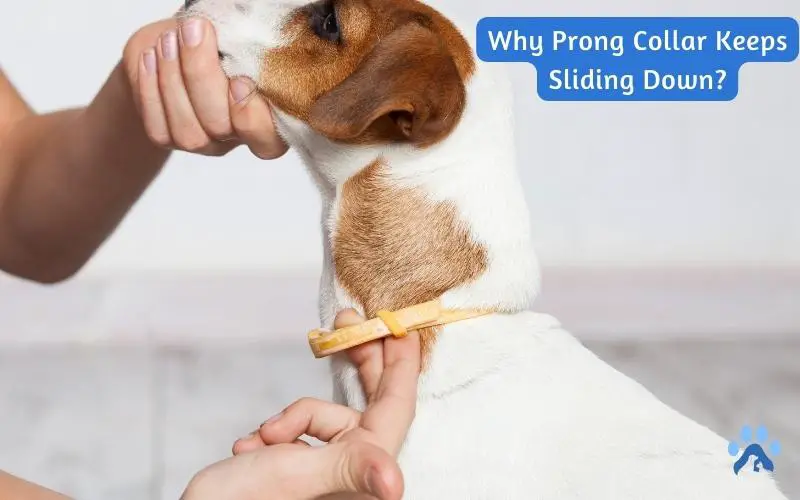Are you having trouble keeping your dog’s prong collar in place? You’re not alone!
If your pup’s prong collar keeps sliding down, the most common cause of this is that the collar is not sized correctly.
Many dog owners struggle with this issue, especially those with long-haired breeds or particularly active dogs.
Thankfully, several simple solutions can be implemented to ensure your dog’s prong collar securely fits and stays in place.
Hence, this blog post will discuss the causes of a prong collar slipping and provide tips on how to fit a prong collar snugly and securely.
How to Fit a Prong Collar to Prevent Sliding Down
Prong collars are a popular, effective tool for training, but if the prong collar keeps sliding down, it can cause discomfort for your dog and become a nuisance to you.
And so, as a pet owner, you must know how to fit that collar on your dog perfectly.
Here are three simple steps you may follow,
Check the Position of the Collar
To begin, the collar should fit snugly but not too tight. In addition, it ought to rest high on the neck, not the ear’s level.
Observing the distance between the prong links is essential to check if the collar is positioned correctly.
There should be two fingers of space between the collar and the neck, and the links should be parallel to the neck.
If the collar is too loose, it should be tightened by pushing the links together; if it is too tight, it should be loosened by pulling the links apart.
Try Another Link Size
To ensure a prong collar fits appropriately to prevent sliding down, start by measuring the neck’s circumference using a flexible measuring tape.
Choose the appropriate size link for the neck’s circumference and use the link closest to the size of the neck.
Push the prong tips through the link and attach the collar. If the prong tips are excessively long, use a cutting tool to remove the extra material.
Lastly, when fitting the collar, ensure the prong tips are pointing down, and the collar link is at the top of the neck.
Use an Additional Collar
When the prong collar keeps sliding down, an additional collar can be used for added security.
A secondary collar, such as a martingale, can be worn underneath the prong collar and cinched up snugly. This helps to keep the prong collar in place and helps prevent it from slipping off.
It is essential to check both collars regularly for fit and comfort and to ensure that either collar is not pinching the neck.
Lastly, using the collar properly and following the manufacturer’s instructions is essential.
Prong Collars Safety
Prong collars or pinch collars are controversial training tools used to train dogs. These collars are designed to provide a corrective stimulus when the dog pulls on the leash.
While some proponents of prong collars argue that they are a humane and effective way to train dogs, many animal welfare advocates and veterinarians express concern over their use.
The potential risks of using prong collars include physical injury to the dog, psychological damage, and even behavior problems such as aggression.
Prong collars should only be used under the guidance of an experienced professional who can provide safe and practical training. The risks of using prong collars can outweigh the potential benefits if misused.
Use Only After All Humane Methods Have Failed
Only in extreme cases, when all other humanitarian measures have failed, may prong collars be applied.
Prior to using a prong collar, it is essential to look into other options, such as positive reinforcement and reward-based training.
If these techniques fail to be effective, pet owners should consult a professional trainer who can provide additional resources and methods to modify their pet’s behavior.
Using a prong collar should only be done after all other methods have been exhausted and should be used with the advice of an expert.
Clearing the Prong Collar Myths
Many owners think the prong collar must be worn tight to be effective. This is entirely a false assumption.
Another important myth that needs to be addressed is that the prong collar will slip down on the dog’s neck as they move or pull.
This is incorrect- the prong collar is designed to apply pressure on the dog’s neck when it is pulled on or tugged and will stay in place when fitted and adjusted correctly.
Prong collars are not designed to inflict pain on a dog. In fact, a prong collar is designed to mimic the sensation of a mother dog’s corrective nip to instruct her pups.
These collars are not designed to be used as a form of punishment but as a positive reinforcement tool.
Prong Collar Training: How to Do It?
Training your dog with a prong collar can be successful, but it’s essential to do it correctly. Here’s how to do it:
Purchase a high-quality prong collar from a reputable retailer. It is crucial because the collar should fit your dog correctly and not hurt them.
Then, put the collar on your dog and let them get acclimated to it. Let them wear it around the house for a few days so that they can get used to the feel of it.
You can start the training session once your dog is accustomed to wearing it. Begin with basic commands like sit and stay.
If your dog does not respond to the command, give a slight tug on the leash attached to the collar. This will give your dog a gentle correction.
Continue doing this until your dog regularly obeys your orders. Then you can begin adding more complex commands.
Be consistent with your commands and the timing of rewards and punishments. This will help your dog learn what behavior is expected from them.
Additionally, be sure not to use the prong collar excessively, or it could lead to aggression in your dog.
Conclusion
Prong collars can be an excellent choice for dogs with leash-pulling tendencies, but their effectiveness can be decreased if the collar keeps sliding down.
Therefore, ensuring that your dog’s prong collar fits appropriately to work to its full effect is essential.
If your dog’s prong collar keeps sliding down, you should consider getting a larger size that fits its neck better.
You can also try using a martingale collar if you are uncomfortable with the idea of a prong collar.
With the correct size and fit, your dog will be more comfortable wearing its prong collar, and you can be assured that it is working correctly.
FAQs – People Also Ask
Should a prong collar slide?
The use of prong collars is a controversial topic among dog owners. Some believe a prong collar should slide, while others feel it should be kept tight.
Proponents of allowing the prong collar to slide argue that the flexibility allows the collar to move with the dog, reducing the likelihood of choking.
They contend that it is more comfortable for the dog and humane than a tight-fitting collar.
On the other hand, those who prefer a tight prong collar argue that the collar is more secure, reducing the likelihood of the dog being able to slip out of it.
Ultimately, whether or not to allow a prong collar to slide should be based on the dog’s behavior and needs.
What happens if a prong collar is too loose?
If a prong collar is too loose, it may not be effective in providing guidance or corrections to a dog’s behavior.
It may also slip over the dog’s head or slide down the neck. But, again, this would create a more serious problem of being unable to provide guidance or corrections.
Additionally, the dog may become accustomed to the loose collar and not respond to corrections.
How do I stop my dog from slipping his collar?
Stopping your dog from slipping his collar is a significant safety measure. The first step is to confirm that your collar fits correctly.
Additionally, it would be best if you used a buckle collar rather than a slip collar, as these are more secure and less likely to come undone.
Lastly, regular practice with your dog in a secure area, using positive reinforcement, can help your pup learn how to walk better on a leash and not slip his collar.
How do you secure a prong collar?
The collar should be placed behind the dog’s ears and under the jaw. It should fit snugly yet not be overly restrictive.
The prongs should rest against the skin, with only enough room to fit two fingers between the collar and the neck.
To finish, the excess chain should be looped through the prong link and secured with a quick-release clip.
Is there a wrong way to put a prong collar that makes it slide?
Indeed, and not only that, but if a prong collar is smaller in size, it could also be another potential reason why it might slide out from your dog’s neck.



